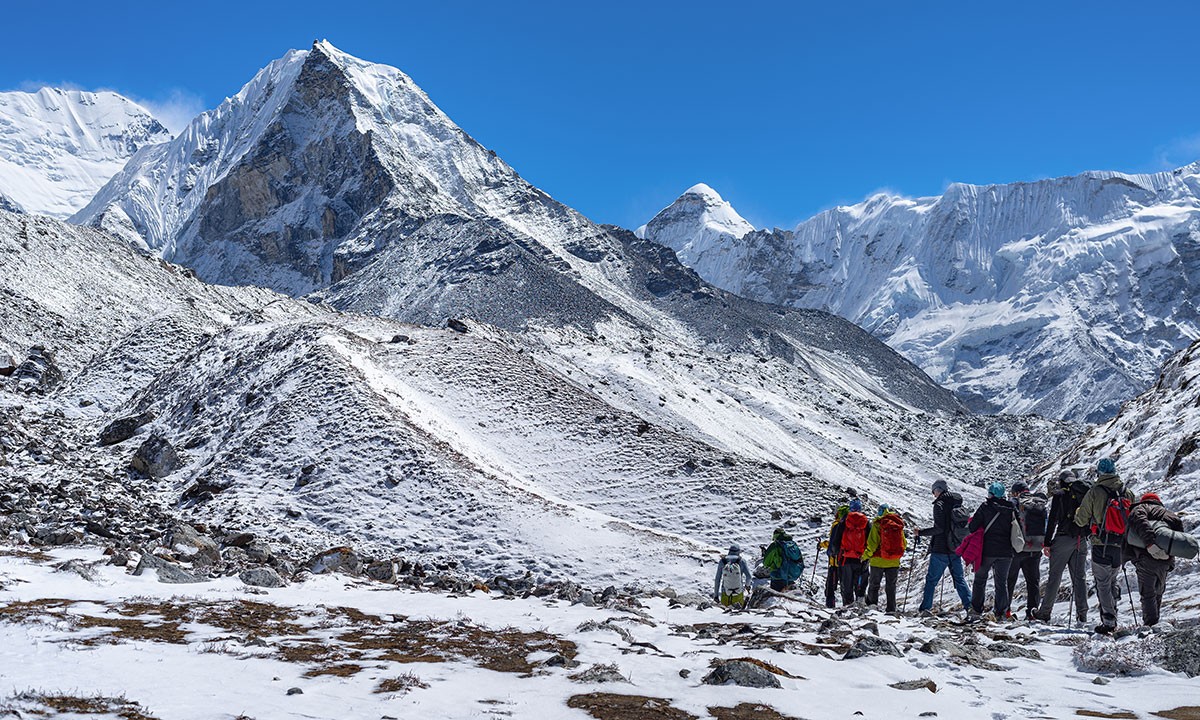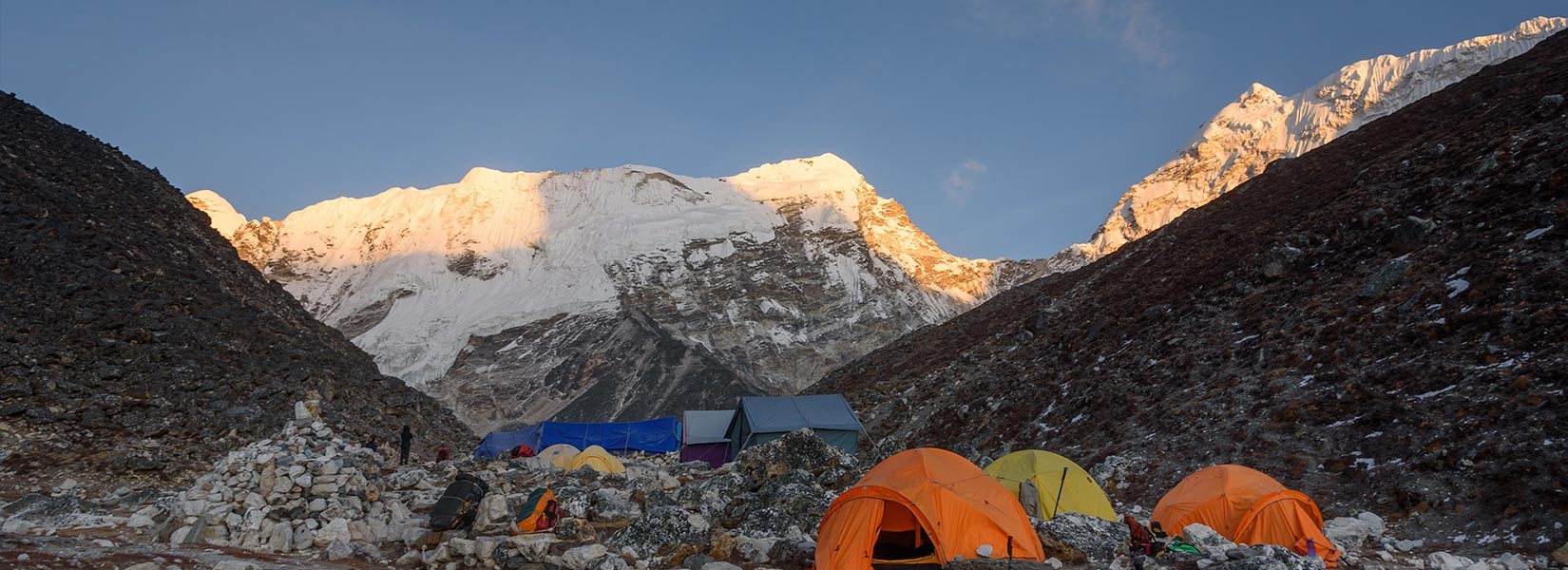How Technical is Island Peak?

Graded ‘2B Difficulty Level’ in the Alpine Grading system Island Peak is a moderately difficult mountain to ascend and definitely not a trekking peak. During your expedition on the mountain, you will need to use different technical tools like ropes, harness gears, ice peaks, and crampons with the need for technical work like ascenders, descenders, and using stairs. As this peak in the Himalayas is considered to be a practice peak for the summit of Everest and an easy straight walk-up mountain, it may not be technically challenging for experienced mountaineers. But, if you are new to the mountain expedition and haven’t prepared well for the climb, this adventure will push you to your wits’ end.
As the altitude gain is significant in this adventure, you will also need to properly acclimatize to the high-altitude environment, which will be a key factor in determining your successful summit. Even though it is a physically demanding and tough peak, Island Peak climbing is still doable with the right amount of preparation.
The summit day is especially difficult and technical as you will walk around 9-10 hours on this day’s expedition. On this day, you will climb the vertical ice wall that leads to the summit; you need to maneuver yourself from the anchor point to point using your harness on the fixed ropes.
Island Peak Climbing in Spring
Spring is the most popular season for mountaineering and trekking expeditions in Nepal; this is the season when the entire Himalayan region comes alive and blooms with life in every corner, from the tropical region to temperate and high-Himalayan. The weather in this season is mild and offers great visibility to the adventures; the days are longer and bright making it a perfect fit for long expeditions.
This pleasant season welcomes the adventures on its brightly colored trails filled with nature’s charm and aroma mixing well with the clear white Himalayan vistas that touch the clear blue skies. If you are an avid nature lover, you simply can’t miss the opportunity to explore the high Himalayas when it is at its peak. The temperature of the region is around 15°C to 17°C during the daytime and can drop up to -8°C at night time and early morning.
Island Peak Climbing in Autumn

Autumn (September to November) is one of the peak seasons for high-altitude adventure in Nepal. After the monsoon's summer heat and heavy rainfall, this weather-steady season offers clear visibility and cool chilly weather, making it the perfect time for an outdoor adventure. Although the paths may not be lightened up by colorful flowers like, in spring, the freshly washed landscapes and well-nourished waterfalls and rivers along the trail make Island Peak climbing adventure this season really exhilarating and thrilling.
The temperature of the region hovers around 0°C to 15°C, and it can drop as low as -15°C during the night and early morning. The moist trekking landscapes, cool and chill morning- evening breezes, and the unprecedented views of the Himalayan landscapes, makes the Island Peak climbing this season a truly wonderful and memorable experience.
Training and Preparation
Summitting mountain peak of the Himalayas that is in the 6,000-meter category isn’t an easy feat. As this expedition leads you to the summit of the Island Peak, it is physically demanding, and the elevation jump points to reach the peak at 6,189 meters is no joke either. Preparing for this mountain expedition like it's a high-altitude trekking expedition just because the ‘practice peak for Everest’ tag just might not make the cut.
In general, it is recommended that you should prepare at least 8-12 weeks prior to any high-altitude trekking adventure, making the preparation sufficient for the draining and exerting adventure. But, in the case of this mountain expedition, you will have to at least start your training regime 4- 6 months prior to the climb. Here are a few preparation plans you can work on during your preparation period:
Strength Training
Strength training is one of the most significant factors that determines the success of this expedition. As you will be traversing across diverse steep landscapes during the trekking part and, of course, depend on your muscular strength during the ascending to the summit using ropes and walking on steep slopes carrying heavy crampons. You need to prepare considering these factors for Island Peak climbing:
Strength Training Exercises
- Push-ups
- Weightlifting
- Bicep curls
- Plank
- Dumbell row
- Kettlebell swing
- Squat
- Lunges
- Step up
- Deadlift
- Leg curl, leg press
Cardiovascular Training
Cardiovascular training helps to boost your stamina and endurance level improving your overall physical performance. As cardiovascular exercises help to improve your body’s capabilities to deliver oxygen to muscles, it comes in really handy, especially during high-altitude adventures with low oxygen saturation level.
Cardiovascular Training Exercises
- Swimming
- Cycling
- Cardio exercise
- Stair running
- Rowing
- Jumping rope
- Water aerobics
- Hiking
- Brisk Walking
- Burpees
Mental Preparation
It may seem like not so significant factor as this expedition mostly depends on the physical capabilities, which is true to some extent. But your determination and motivation also play a vital role when it comes to successfully completing an expedition, especially if you are new to the alpine adventure and it is completely uncharted terrain for you.
Mental Preparation for Island Peak Climbing
- Meditation and practiced breathing
- Mental toughness practice
- Learn to leave your comfort zone
- Stay positive throughout the experience
- Prepare for discomfort
- Enhance your confidence level
Food and Accommodation

As Island Peak climbing follows the trekking route of the mainstream trekking expedition in the country, Everest Base Camp Trek, you will have the opportunity to enjoy an extensive set of eateries and accommodating facilities during this expedition.
You will be served meals three times a day at the teahouses throughout the trekking and prepared by our expedition members during the camping section.
For Breakfast
- Black, milk, ginger lemon tea, and coffee
- Eggs; boiled, scrambled, omelet
- French toast, toast with jam or honey
- Porridge
- Pancakes
- Oats
- Pudding
- Bread
- Chapatti
- Paratha
- Cornflakes
For Lunch and Dinner
- Daal Bhaat Tarkari (Tradtional Nepali dish)
- Noodles
- Pasta
- Pizza
- Potato (fries, boiled, steamed)
- Dumplings
- Sandwiches
- Marconi
- Spaghetti
- Thupka
- Yak Stew
- Tasampa
- Shyakpa
- Tingmo
- Riki kur
- Shyphale
- Rildok
As for accommodation, there is a wide range of tourist-friendly accommodation facilities along the route. The quality of services may differ depending on the cost of the expedition, but in general, teahouses along the trail offers bed, mattress, pillows, and blankets, including bathroom and shower facilities. However, as the rise in the elevation point of the trek, you will need to adjust to more basic services as it is impossible to have every kind of perk at such high-altitude.
You may also like:
FAQs About Island Peak Climbing

1. What is the best season for Island Peak climbing?
The best for Island Peak climbing is considered to be the peak seasons like spring (March to June) and autumn (September to November). Both the spring and autumn seasons have stable weather and warm temperature; these seasons offer unobstructed views of the Himalayas and surrounding, making it the best time for the expedition.
2. Do I need prior climbing experience for Island Peak climbing?
Although previous climbing experiences do certainly help with the expedition, you don’t need any prior experience for Island Peak climbing. In fact, this beautiful peak in the Himalayas is considered to be a practice where mountaineering beginners come to test their skills and gain experience.
3. How challenging is Island Peak climbing?
Island Peak climbing is a technical climb where you will have to use mountaineering equipment; you will also need a good amount of stamina and endurance level on this expedition that exceeds the 6,000 meters altitude. You will be also given pre-ice climbing training at the base camp, where you will be taught to skillfully use mountaineering tools like ropes, harness gears, ice peaks, and crampons.
4. What are the physical standards for this expedition?
As this mountain expedition takes place at a significant altitude, you will need a good level of physical fitness to complete the adventure successfully. It is recommended that you start your preparation at least 4- 6 months before the actual expedition.
5. What kind of accommodation is available for Island Peak climbing?
You will accommodate in the teahouses during the trekking trails of the Island Peak climbing expedition and in tented accommodation at Peak Climbing Base Camp. Our team will take care of your essentials, from food to lodging, so you will have a comfortable experience even when camping.
6. Do you provide an oxygen supply if needed?
Yes, you can get the oxygen supply for the higher altitudes if needed; the teahouses in the Lobuche and Gorakshep regions offer oxygen bottles at an extra cost if needed. We also provide an oxygen supply that you can pre-book and can be carried with you for use in higher altitudes.
7. How high is Nepal’s Island Peak?
The Island Peak is at an altitude of 6189 meters (20,305 feet); situated between Ama Dablam and Mt. Lhotse, this peak is an extension of the Lhotse Shar to the south end.
8. Who named Island Peak?
Eric Shipton’s expedition team named this alluring peak in the Himalayas as ‘Island Peak’ in 1952. As this mountain resembles the shape of an island in the sea of ice when viewed from Dingboche, it was named the Island Peak, which was later renamed to ‘Imja Tse’ in 1983.
9. How much does Island Peak climbing cost?
In general, the cost of Island Peak climbing ranges from US$ 2200 to US$ 2700 depending on the set of itineraries. We here at Marvel Adventure offer this exhilarating experience at just US$ 2,195, the best value package in Nepal without compromising in any aspect.
10. How long does it take to complete the expedition?
Island Peak climbing takes 16 days to complete; this includes following the route of mainstream Everest trekking after entering Lukla and returning to Lukla after a successful summit of the mountain.
11. Is Island Peak climbing technical?
Yes, the Island Peak expedition is considered a technical climb. Although you don’t need any previous mountaineering experience to ascend this mount, you will be using different mountaineering equipment while scaling to the summit of this mountain.
12. Can you see Mt. Everest from Island Peak?
Yes, as the Island peak is situated close to Mt. Everest, you can enjoy the spectacular views of the tallest mountain in the world as well as other adjacent peaks in the Himalayas like Ama Dablam, Lhotse, Pumori, Nuptse, Pumori, and Makalu.
13. Can you climb Island Peak without a guide?
No, according to the new policy of the Nepal Government, solo climbers and trekkers from foreign countries will not be allowed for the solo expedition. The climbers and trekkers will need to hire government-licensed guides or join guided expedition groups.
14. Which is harder, Mera Peak or Island Peak?
Mera Peak, the highest trekking peak in the country, is graded ‘Alpine Grade PD,’ which means it is a slightly difficult climb with some technical segments. However, considering the ‘2B Alpine Grading’ of Island Peak, it is more difficult to scale than the Mera Peak.
15. Is Island Peak climbing worth it?
If you are looking for an expedition that isn’t too strenuous or too easy, which you can use to check out your skill levels, then Island Peak climbing is an ideal peak for you. Island Peak, in the 6,000 meters class, is a significant mountain that provides exhilarating adventure for both beginners and season mountaineering enthusiasts.











